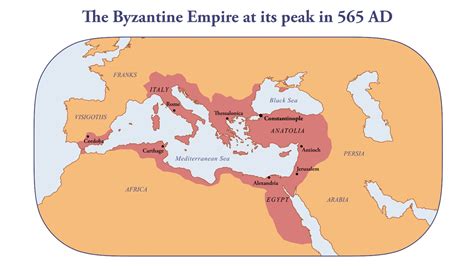Introduction

The Byzantine Empire, also known as the Eastern Roman Empire, was a significant civilization that emerged from the division of the Roman Empire in 395 CE. This empire thrived for over a millennium, leaving an enduring legacy that shaped the course of European and Middle Eastern history.
Origins and Establishment
The Byzantine Empire emerged in the eastern half of the Roman Empire, with its capital in Constantinople (present-day Istanbul). Emperor Constantine I founded the city in 330 CE and made it the new administrative center of the Roman Empire. The empire’s territory encompassed significant regions of present-day Europe, Asia Minor, and North Africa.
Characteristics of the Byzantine Empire
1. Religious Influence:
The Byzantine Empire was deeply influenced by Christianity. Emperor Theodosius I declared Christianity the official religion of the empire in 380 CE. The empire became a center of Orthodox Christianity, leading to the establishment of numerous monasteries and churches.
2. Imperial System:
The Byzantine Empire maintained a centralized and authoritarian imperial system headed by the emperor. The emperor held absolute power and commanded the army, controlled the administration, and represented the state.
3. Bureaucracy and Administration:
The empire had a highly developed bureaucracy, which effectively managed the vast territories and diverse population. The imperial administration relied on a system of taxation, law enforcement, and diplomacy to maintain order and prosperity.
4. Cultural Achievements:
The Byzantine Empire produced remarkable cultural achievements in the fields of art, architecture, and literature. The empire’s iconic churches, such as the Hagia Sophia, showcased a blend of classical Roman and Eastern influences. Byzantine mosaics, icons, and manuscripts are highly valued for their aesthetic beauty and historical significance.
5. Economic Prosperity:
The Byzantine Empire enjoyed significant economic prosperity during its early centuries. Constantinople became a major center of trade and commerce, connecting the East and the West. The empire’s control of the Mediterranean Sea enabled it to thrive through maritime commerce.
Decline and Fall
The Byzantine Empire experienced periods of decline and resurgence throughout its history. The empire faced challenges from invading forces, including the Persians, Arabs, and Seljuk Turks. In 1204, the Crusaders besieged and captured Constantinople during the Fourth Crusade, leading to the sacking of the city and the establishment of a Latin Empire in the east.
Despite attempts to recover, the Byzantine Empire continued to decline in the face of Ottoman expansion. Constantinople finally fell to the Ottoman Turks in 1453, marking the end of the Byzantine Empire.
Legacy of the Byzantine Empire
The Byzantine Empire left an indelible mark on world history. Its impact is evident in:
1. Christianity and Orthodox Tradition:
The Byzantine Empire preserved and spread Orthodox Christianity, which became the dominant religion in many parts of Eastern Europe and the Balkans. The empire’s monasteries and churches served as centers of religious scholarship and intellectual activity.
2. Codification of Roman Law:
The Byzantine Empire’s Corpus Juris Civilis, a collection of Roman laws compiled under Emperor Justinian I, became the foundation of modern civil law systems in many countries.
3. Architectural Innovations:
Byzantine architectural styles, such as the dome and vault, influenced the design of subsequent buildings in Europe and the Middle East. The empire’s churches, monasteries, and palaces continue to be admired for their architectural beauty.
4. Iconography and Art:
Byzantine iconography, featuring stylized and symbolic depictions of religious figures, became influential in Eastern Orthodox art and iconography. The empire’s mosaics, frescoes, and icons are renowned for their intricate craftsmanship and religious significance.
Conclusion
The Byzantine Empire played a pivotal role in the development of civilization in Europe and the Middle East. Its legacy of Christianity, law, architecture, and art continues to shape the world today. The study of the Byzantine Empire in AP World History provides students with a comprehensive understanding of this remarkable civilization and its enduring influence throughout history.
